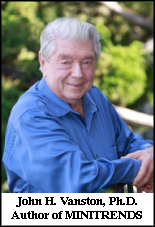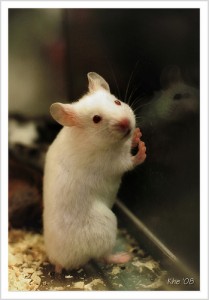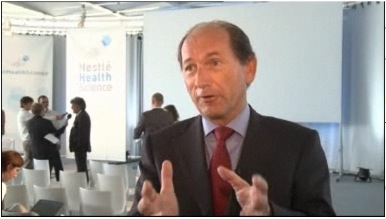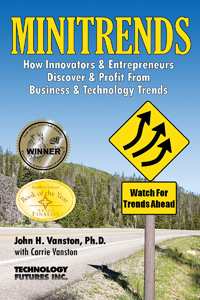“Nine Emerging Minitrends to Watch” by Dr. John H. Vanston, MINITRENDS Author & Chairman, TFI
December 28, 2010
 Happy holidays to Minitrends blog readers! We appreciate your interest in our Minitrends posts and activities. As we start the new year, there will be many opportunities for those who are alert enough to recognize emerging trends, perceptive enough to realize their importance, and clever enough to take advantage of them. Here I suggest nine Minitrends—emerging trends that will become significantly important within 2-5 years, but are not yet generally recognized—that are well worth examining for possible action by those ambitious individuals who seek to start new ventures or keep existing businesses innovative and competitive.
Happy holidays to Minitrends blog readers! We appreciate your interest in our Minitrends posts and activities. As we start the new year, there will be many opportunities for those who are alert enough to recognize emerging trends, perceptive enough to realize their importance, and clever enough to take advantage of them. Here I suggest nine Minitrends—emerging trends that will become significantly important within 2-5 years, but are not yet generally recognized—that are well worth examining for possible action by those ambitious individuals who seek to start new ventures or keep existing businesses innovative and competitive.
Unlike megatrends, Minitrends are of a scope and importance to offer attractive opportunities to individual entrepreneurs, decision-makers in small and mid-size businesses, innovative thinkers in large companies, and adventuresome investors. In my new book, MINITRENDS: How Innovators & Entrepreneurs & Discover & Profit From Business & Technology Trends, I categorize the nine Minitrends below to those most applicable to different-sized groups. (In the book, I also discuss the background, current trends, and business opportunities of each of these Minitrends in more depth.) I do the same categorization below, but in reality, all provide opportunities to perceptive individuals in all-sized businesses.
Minitrends Particularly Applicable to Individuals or Small Groups of Individuals:
1. Expanding Involvement in Virtual Worlds (Free Virtual Worlds book excerpt available):
Virtual worlds are computer-based platforms that allow participants to engage in a wide range of real-world type activities, e.g., buying and building virtual world property, furnishing virtual world homes and offices, producing and selling virtual world goods, traveling, taking part in virtual world social activities such as parties and fundraisers, and communicating with other participants. Increasingly, virtual worlds are being used for educational purposes, product advertisements, new product modeling and testing, identification of new markets, and uncovering unexpected problems with new marketing programs.
2. Support for People Working at Home:
Although an increasing number of people are now conducting all or part of their work at home, these people often find they miss interacting with others and miss the convenience of facilities, equipment, and administrative support. A number of solutions are emerging to better meet the needs and desires of people working at home, including small offices or meeting rooms that can be rented by the day or the hour; chat rooms where people can meet informally to discuss ideas; semiformal groups that meet regularly to establish person-to-person interactions; and temporary support staffs organized to provide administrative assistance as needed.
3. Expanding Capabilities of Advanced Websites:
Although the World Wide Web had proven to be extremely popular, many believed a more interactive platform that took advantage of the Web’s power to communicate would be desirable (Web 2.0). Programmers are now expanding the capabilities of the Web to substitute computer activities for human activities, particularly activities that are repetitive, burdensome, and uninteresting (Web 3.0). Many believe Web 3.0 will eventually lead to effective artificial intelligence that can interact with humans in natural language.
Minitrends Particularly Applicable to Small and Medium-Size Companies:
4. Increasing Interest in Privacy:
Recent advances in technology, together with an increasing willingness of many to make personal information more easily available are threatening traditional concepts of privacy in terms of messaging, personal profiles, and identity. Techniques for countering these invasions of privacy, such as personal caution, technology aids, and group action are now being developed.
5. New Approaches to Giving and Receiving Advice:
Individuals and organizations commonly seek expert advice when making important decisions. In providing such advice, large consulting firms with large, multidisciplinary staffs, well-structured processes and procedures, huge computer capabilities, and long-standing reputations have traditionally had a major advantage. However, the ever-increasing power and ubiquity of information gathering, processing, and communicating technologies, small and medium-size consulting groups are often able to give more focused, timely, and user-friendly advice than the larger firms.
6. Evolution of Meaningful Maturity:
The twin trends of increasing life spans and decreasing retirement ages have caused a steady increase in retirement years. Because of social, personal interest, and/or financial reasons, many older individuals are either staying in their jobs longer or returning to the workforce. Their ability to utilize their experience, skills, and dedication effectively will depend on their current capabilities, their desires, and open opportunities to those willing to assist them.
Minitrends Particularly Applicable to Large Companies:
7. Advances in Digital Manufacturing:
Advanced digital manufacturing (ADM) processes build complex, custom-made parts by the addition of successive layers of material rather than traditional machining processes that cut, bend, and machine a part from stock material. The processes allow quicker production of prototypes and small production runs at a much lower cost. Recent ADM advances, including improved yield rates, reduced time-to-market, increasing variety of materials, and advances in 3D modeling software, have made ADM processes increasingly attractive to many manufacturers.
8. Increasing Electricity Use in Manufacturing:
The characteristics of electric power, such as high power density, no heat transfer medium requirements, controlled energy distribution, reduced material waste, and less environmental impacts, provide a number of benefits to manufacturing processes. Its use, however, has been limited by its relatively high cost. A number of factors, including advances in control technologies, changing customer needs, global competition, and increasing concern about the environment, are driving an increasing growth in the use of electricity in industrial processes.
9. New Applications of Nanotechnology:
When many substances are reduced to nano-size (100 nanometers or less) they often exhibit very different physical, electrical, chemical, and optical properties from the same substance at macro-size. These new properties often provide very unique and useful characteristics to nano-materials that can be used in a wide range of practical applications, such as cancer treatment, very high strength materials, special electronic systems, and water purification. Improved production techniques, decreased costs, and growing experience and understanding are increasing the practical applications of nanotechnologies
Minitrend involvement can give you a way to separate yourself from your colleagues and contemporaries. It provides a means for materially improving your business situation, your financial standing, and your personal satisfaction. I hope the Minitrends listed above will assist you or inspire you to launch your own exciting, profitable Minitrend Adventure that allows you to utilize your imagination, your logic, your innovative nature, and your basic good sense in the coming year.
Copyright 2011. Please feel free to reprint this article in whole or part with due credit to: “by Dr. John H. Vanston, MINITRENDS Author and Chairman, Technology Futures, Inc.” Thanks!
A Longer Lifespan with Science and Work
December 10, 2010
 Since I was born, average life expectancy in the U.S. has increased by 10 years, from about 68 years to 78 years. In the next decade, it will increase by another 20 years, according to futurist Ray Kurzweil, who predicts that by the year 2019, the life expectancy of someone born in the U.S. will be over 100 years.
Since I was born, average life expectancy in the U.S. has increased by 10 years, from about 68 years to 78 years. In the next decade, it will increase by another 20 years, according to futurist Ray Kurzweil, who predicts that by the year 2019, the life expectancy of someone born in the U.S. will be over 100 years.
A celebrated M.I.T. scientist, Kurzweil has embarked upon a dietary regimen designed to improve his longevity to the point where “life expectancy is no longer a viable term in relation to intelligent beings.” Until recently, the dominant method of life extension has been calorie restriction. If you can cut your daily calories in half without impacting your vitality, studies show you will live considerably longer.
Last week, another breakthrough offered hope for an engineered end to aging. The forever elusive “fountain of youth” is now pumping out telomerase. Telomerase is an enzyme that keeps telomeres from unravelling. Ewen Calloway, a biotech writer for the journal Nature, which published this new Harvard study, explains the significance of telomeres:
Chromosomes have caps of repetitive DNA called telomeres at their ends. Every time cells divide, their telomeres shorten, which eventually prompts them to stop dividing and die. Telomerase prevents this decline in some kinds of cells, including stem cells, by lengthening telomeres…
In the Harvard study conducted by the Dana-Farber Cancer Institute and Harvard Medical School, mice were genetically engineered with dormant telomerase, resulting in their rapid and premature aging. Feeding the mice a chemical called 4-OHT reactivated telomerase production, and the mice were remarkably restored to a normal age.
There is hope that telomerase could be used to stimulate the growth of neurons, restoring vitality to the worn-out brains and other organs. However, there’s a catch. Tiffany Kaiser at DailyTech delivers the bad news:
While this therapy is ideal for mice, it will be challenging to translate this type of treatment to humans because slowing the aging process this way could increase the risk of cancer in humans. Mice have the ability to create telomerase throughout the span of their lives, but telomerase eventually discontinues in humans in order to stop cells from overpopulating and possibly turning into cancerous cells.
The promise of the Harvard study is that it shows a reverse in aging, not just a halt to aging. The problem is that it did not extend the lives of the mice one bit; it merely returned them to a normal longevity. Kyle Munkittrick at Discover is also skeptical of the translation of this breakthrough to humans:
It still remains to be seen if telomerase treatments can delay normal aging, reverse normal aging, or extend life in any way in mice. From there scientists have to then figure out what side-effects there are, why those side-effects occur, and then somehow translate the results to human beings. [Emphasis his.]
Perhaps telomerase is not the wonder drug that will keep us alive indefinitely. But something is working to expand our life expectancy, and it might be work. In their new book, MINITRENDS, futurist John H. Vanston and his daughter, Carrie Vanston, note with some surprise that the one trait that links successful entrepreneurs is “exceptionally good health.” Which begs the question, which came first, the health or the work?
Jeannine Stein reports for the Los Angeles Times on a study funded by the National Institute on Aging into the effects of employment on the health of retirees:
The researchers coined the term ‘bridge employment’ to describe the transition period between full-time work and full-time retirement, in which people work part time, are self-employed or temporarily employed. Men and women in that bridge employment category reported fewer major diseases and functional limitations compared with those who were in full retirement.
John and Carrie Vanston devote a significant portion of MINITRENDS to exploring the business opportunities for entrepreneurs resulting from life extension. For some employers, it simply means a larger pool of relatively low-cost, experienced workers. Will other countries be insourcing their busy work to our senior citizens?
The Vanstons also see business opportunities in retooling older workers with modern skills. Already, many retirement homes are locating near universities or on college campuses, to give seniors ready access to both the classes and the culture available from the publicly-funded centers of learning.
As many of us face the prospects of living to be 100 years old, it is comforting to know that those later years can be profitably and pleasurably employed providing valuable services to others. Science will continue to improve our ability to work in our later years, and the exciting work of entrepreneurship will continue to keep us young!
STEVE O’KEEFE
News Editor, Minitrends Blog
Source: The Age of Spiritual Machines, by Ray Kurzweil, pp. 208, 280
Source: “Telomerase reverses ageing process,” Nature, 11/28/10
Source: “Harvard Scientists Reverse Signs of Aging in Mice,” DailyTech, 11/29/10
Source: “Another Tiny, Exciting Step Toward Life-Extension,” Discover, 11/29/10
Source: “Considering retirement? Working might keep you healthier,” Los Angeles Times, 11/14/10
Photo by be_khe (Giang Ho Thi Hoàng), used under its Creative Commons license.
Technology Trends for Seniors
November 2, 2010

Today’s senior citizens have a completely different idea of “retirement” from what that concept has historically meant. Among other things, they plan to use the Internet to stay current and active in their communities and in the workplace.
Those are some of the findings in a recent survey (PDF) completed by the Mather LifeWays Institute on Aging, which polled 435 senior living communities about trends in programs, services, amenities, and environments.
What they discovered was that seniors love their tech! Here are some of the technology trends highlighted in the survey:
- Senior living centers need to incorporate “smart home” technology and wireless connectivity into senior living residences
- Seniors want access to “tele-health technology” in their residences
- Seniors want some variation of the “Beacon Hill” program, a senior resources network that helps arrange for everything from ride-sharing to continuing education for seniors
- Senior center residents are demanding Web-based learning and lifelong learning opportunities
- These socially-conscious seniors want to see residences that are certified environmentally-friendly
Mather LifeWays expects to see a wave of partnerships flourish between senior living centers and educational institutions, green building firms, and technology companies “in order to meet and exceed expectations of the next generation of older adults.”
In their new book, MINITRENDS, John & Carrie Vanston cite the evolution of meaningful maturity as the source of numerous Minitrends:
Within the Megatrend of an aging population, are the Minitrends of people remaining active in the workforce for longer periods of time and increasing movement of elderly individuals to smaller nursing centers.
The Vanstons go on to list several business opportunities resulting from the growing number of healthy, active senior citizens.
A roundup article that appeared recently on the Technology News and Tips blog covers not only the Institute on Aging survey cited above, but also a “New Retirement Survey” from Merrill Lynch and a survey of senior living community owners by Ziegler Capital Markets. These reports concluded that “baby boomers will fundamentally reinvent retirement by living longer and remaining engaged and employed beyond age 65.”
Most of these writings were in the works before retirement-age workers saw their savings slammed by the Great Recession. Today, many more seniors expect to stay in the workforce longer — whether they like it or not — due to financial concerns. There are enormous opportunities waiting for those who can help these “silver surfers” use technology to stay connected, educated, and vital members of their communities and workplaces.
STEVE O’KEEFE
News Editor, Minitrends Blog
Source: “Senior Living Community Trends,” Technology News and Tips, 10/24/10.
Source: “MINITRENDS: How Innovators & Entrepreneurs Discover & Profit From Business & Technology Trends,” Technology Futures, Inc., pp. 104-112.
Source: “Trend Survey Reveals Future of Senior Living Communities — Maintaining Resident Independence a Top Priority” (PDF), Mather LifeWays, 05/19/09.
Image by Ed Yourdon, used under its Creative Commons license.
Engineering Smart Foods to Combat Disease
October 25, 2010

Nestlé CEO Paul Bulcke talks about the creation of Nestlé Health Science and the Nestlé Institute of Health Sciences. Click on image for the video interview.
Swiss food giant Nestlé has announced a series of major investments in developing medicinal foods that target chronic diseases. This comes as the U.S. Federal Trade Commission cracks down on Nestlé and other food companies for dubious health claims made about their products.
Nestlé CEO Paul Bulcke announced the creation of Nestlé Health Science and the Nestlé Institute of Health Sciences at a press conference on September 27, stating that the focus of the new companies will be to “prevent or correct acute chronic diseases with medicinal nutrition.”
A news release issued by Nestlé calls it a combination of “food and pharma,” and provides a list of some of the diseases being targeted:
These two separate organisations will allow Nestlé to develop the innovative area of personalised health science nutrition to prevent and treat health conditions such as diabetes, obesity, cardiovascular disease and Alzheimer’s disease, which are placing an unsustainable burden on the world’s healthcare systems.
The subject of longevity is the source of several trends mentioned in the new book, MINITRENDS, by John and Carrie Vanston. One trend resulting from increasing lifespans is the surge in the number of seniors who work. The authors state that “29% of those in their late 60s were still employed in 2006, up from 18% in 1985.” And that was before the Great Recession eroded retirement funds and home equity.
 One has to wonder about Nestle’s motives in development of these medicinal foods. Nestlé is the maker of many foods that have been linked to chronic diseases, such as childhood obesity. Nestlé was one of 17 food companies that have received letters from the Federal Trade Commission in February, warning that their ads “violated federal law by making misleading statements about disease prevention and health benefits.” Looks like Nestlé is out to bolster the science behind those claims.
One has to wonder about Nestle’s motives in development of these medicinal foods. Nestlé is the maker of many foods that have been linked to chronic diseases, such as childhood obesity. Nestlé was one of 17 food companies that have received letters from the Federal Trade Commission in February, warning that their ads “violated federal law by making misleading statements about disease prevention and health benefits.” Looks like Nestlé is out to bolster the science behind those claims.
SwissInfo.ch, who broke the story on the international wires, seems to be making commentary on the irony of the maker of candy bars now making health bars. It pairs the Nestlé announcement with a video about a government-sponsored study that shows that the “obesity among schoolchildren is increasing.”
What do you think of Nestle’s foray into the billion-dollar market of medicinal foods? Is it Trick or Treat?
STEVE O’KEEFE
News Editor, Minitrends Blog
Source: “Nestlé Health Science S.A. and Nestlé Institute of Health Sciences established to target new opportunity between food and pharma,” Nestlé Press Release, 09/27/10
Source: “Paul Bulcke, Nestlé CEO, talks about the creation of Nestlé Health Science and the Nestlé Institute of Health Sciences,” Nestlé Video, 09/27/10
Source: “Nestlé creates new bond between food and pharma,” SwissInfo.ch, 09/27/10
Source: “POM Wonderful: Not So Wonderful After All, Says the FTC,” FastCompany, 9/28/10


